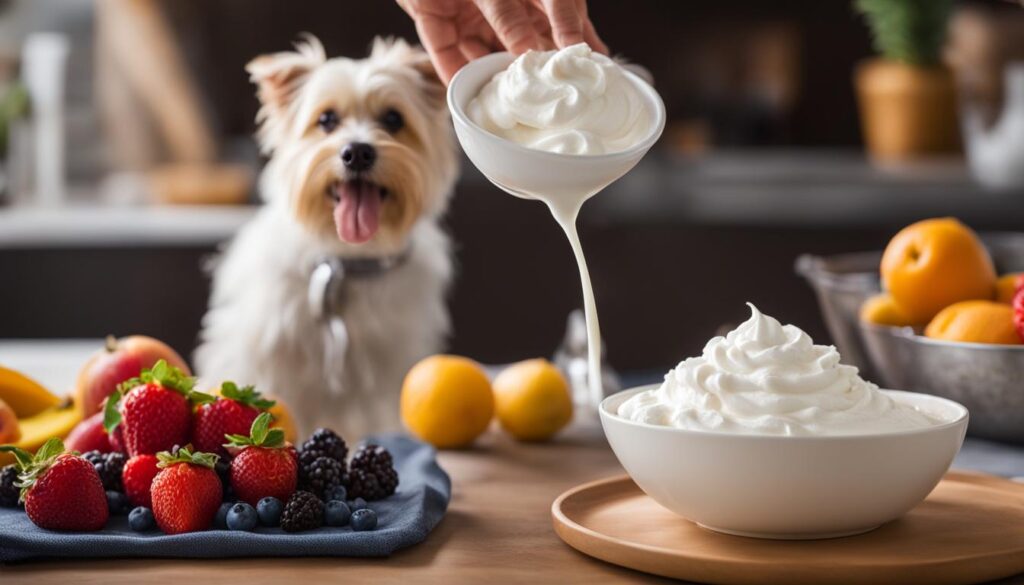When it comes to sharing food with our furry friends, it’s essential to consider their health and safety. One common question that arises is whether dogs can have whip cream. While dogs may beg for a taste of this delicious treat, it’s crucial to understand the potential risks and make informed choices for their well-being.
Whipped cream contains sugar, fat, and dairy, which can have an impact on a dog’s digestive system. Some dogs may experience stomach upset, especially if they have a lactose intolerance. Additionally, certain whipped creams may contain xylitol, an artificial sweetener that is toxic to dogs. It’s important to choose a whipped cream that is free from this dangerous ingredient.
While whip cream can be safe for dogs in moderation, it should only be given as an occasional treat. It’s crucial to offer whip cream in small amounts and monitor how your dog reacts to it. If you notice any signs of discomfort or digestive issues, it’s best to avoid giving them whip cream altogether.
To ensure the well-being of your furry friend, consider exploring dog-friendly alternatives to whip cream. There are various non-dairy options available, such as coconut, soy, or almond-based whipped creams. These alternatives are often safer for dogs and free from lactose, reducing the risk of digestive upset.
Remember, the key is to prioritize your dog’s overall diet and health. While whip cream may be tempting to share, it’s important to consider the potential risks and make choices that are safe and appropriate for your four-legged companion.
Key Takeaways:
- Whipped cream can be safe for dogs in moderation, but it’s important to consider the potential risks and monitor their reaction.
- Dogs with lactose intolerance may experience stomach upset if they consume whip cream with dairy.
- Avoid whip creams that contain xylitol, as it is toxic to dogs.
- Explore dog-friendly alternatives to whip cream, such as coconut, soy, or almond-based options.
- Prioritize your dog’s overall diet and health by offering a variety of safe and nutritious treats.
Can Dogs Have Whipped Cream?

Whipped cream can be a delightful indulgence for humans, but what about dogs? As a professional copywriting journalist, I’ve studied the subject extensively, and here’s what I’ve found.
Dogs can have whipped cream, but it’s essential to exercise caution and consider a few factors before sharing this sweet treat with your furry friend.
First and foremost, it’s crucial to choose whipped cream that is safe for dogs. Some whipped cream products contain xylitol, an artificial sweetener that can be toxic to dogs. Always read the ingredients list carefully and ensure that the whipped cream you offer to your dog does not contain this harmful substance.
Furthermore, it’s important to be mindful of any nut-based ingredients in the whipped cream. Dogs may be allergic to certain nuts or have difficulty digesting them, which can lead to digestive problems and discomfort. To avoid any potential issues, opt for whipped cream varieties that do not contain nuts.
Additionally, it’s worth considering that whipped cream is a dairy product. Dogs can be lactose intolerant, meaning they have difficulty digesting lactose, a sugar found in milk and other dairy products. If your dog has lactose intolerance, consuming whipped cream with dairy could result in stomach upset, such as bloating, gas, or diarrhea.
So, while whipped cream can be safe for dogs in moderation, it should not be a regular part of their diet. Treat it as an occasional indulgence, offering small amounts as a special treat to avoid any potential gastrointestinal issues.
Remember, every dog is unique, and their tolerance to whipped cream may vary. It’s always essential to monitor your dog’s reaction to new foods and adjust the serving size accordingly. If you’re unsure how whipped cream will affect your dog, consult with your veterinarian for personalized guidance.
To summarize, here are the key points to consider when it comes to dogs and whipped cream:
- Choose whipped cream without xylitol and nut-based ingredients.
- Remember that whipped cream is a dairy product, and some dogs may have lactose intolerance.
- Offer whipped cream as an occasional indulgence in small amounts.
- Monitor your dog’s reaction and adjust serving sizes accordingly.
By following these guidelines, you can ensure that your four-legged companion enjoys the occasional taste of whipped cream without compromising their health and well-being.
Whipped Cream Safety Infographic:
| Whipped Cream Safety | Key Considerations |
|---|---|
| Safe for Dogs? | Yes, in moderation |
| Ingredients to Avoid | Xylitol, nut-based products |
| Lactose Intolerance | Some dogs may have difficulty digesting dairy |
| Serving Size | Offer small amounts as an occasional treat |
How Much Whipped Cream is Safe for Dogs?
The amount of whipped cream that is safe for dogs depends on their size and tolerance. It’s important not to give dogs a large serving of whipped cream, especially if they have never had it before. Whipped cream should be considered an occasional treat rather than a regular part of their diet. For most dogs, a small amount, such as a spoonful or a dixie cup-sized portion, should be sufficient. It’s crucial to monitor how a dog reacts to whipped cream and adjust the serving size accordingly.
Dog-Friendly Alternatives to Whipped Cream

Instead of whipped cream, there are several dog-friendly alternatives that can be used as treats. These alternatives pose a smaller risk to a dog’s digestive system and can provide a safe and healthy option. Here are some options to consider:
- Vegan Whipped Cream: Made from plant-based ingredients, vegan whipped cream is a dairy-free alternative that dogs can enjoy. It is usually made from ingredients like coconut milk or soy-based products.
- Coconut Whipped Cream: Another dairy-free option, coconut whipped cream is made from the cream of coconut milk. It’s important to choose a brand that doesn’t contain added sugars or sweeteners.
- Oat Whipped Cream: Made from oat milk, this alternative is suitable for dogs with lactose intolerance or dairy allergies. Oat whipped cream is usually free from xylitol and nut-based ingredients.
- Sugar-Free Whipped Cream: Opting for sugar-free whipped cream can help reduce the risk of health issues associated with consuming excess sugar. However, it’s important to choose a brand that doesn’t contain artificial sweeteners like xylitol.
When choosing dog-friendly treats as alternatives to whipped cream, it’s important to check the ingredients list and avoid products that contain xylitol or nut-based ingredients, as these can be harmful to dogs. The priority should always be to provide treats that are safe and healthy for your canine companion.
Chicken-Flavored Whipped Cream for Picky Eaters
For dogs who are picky eaters, a homemade chicken-flavored whipped cream can be a great option. This can be made by mixing chicken broth with a dairy-free whipped cream alternative. It provides a tasty treat that dogs can enjoy without the potential risks associated with traditional whipped cream.
The Impact of Dairy on Dogs
Dogs do not tolerate dairy products well due to lactose intolerance. Most dogs have some degree of lactose intolerance and may experience symptoms such as tummy rumbles, frequent and smelly flatulence, bloating, and intestinal discomfort after consuming dairy-based products. While some dogs may be able to tolerate small amounts of dairy as a treat, it’s generally best to avoid giving them whipped cream made from cow’s milk. It’s important to consider a dog’s individual tolerance and choose alternatives that are easier on their digestive system.
The Risks of Pancreatitis in Dogs

Pancreatitis is a serious condition that can affect dogs and lead to various health problems. It occurs when the pancreas, an organ located near the stomach, becomes inflamed. Pancreatitis can be caused by several factors, including dietary indiscretion, certain medications, infections, and even pancreatic tumors.
Feeding dogs high-fat foods, such as whipped cream, can increase the risk of pancreatitis. The pancreas plays a crucial role in the digestion of fats, and when overloaded with excessive amounts of fat, it can become overwhelmed and inflamed. This inflammation can cause significant discomfort and potentially severe complications for dogs.
Causes of Pancreatitis in Dogs
The causes of pancreatitis in dogs can vary. Some dogs may develop pancreatitis due to consuming a large amount of fatty foods, while others may be predisposed to the condition due to genetics or other underlying health issues. Additionally, certain medications or infections can also trigger pancreatitis in dogs.
While occasional indulgences are generally fine, it’s important to note that high-fat foods, including whipped cream, should not be a regular part of a dog’s diet. Restricting your dog’s access to fatty foods can help minimize the risk of pancreatitis.
Symptoms and Treatment for Pancreatitis in Dogs
The symptoms of pancreatitis in dogs can vary, but may include vomiting, diarrhea, abdominal pain, loss of appetite, and weight loss. If you notice these symptoms in your dog, it’s important to consult with a veterinarian as soon as possible for proper diagnosis and treatment.
Treatment for pancreatitis in dogs may involve rest, IV fluids to maintain hydration, pain relief medication, and a special diet. Dogs with pancreatitis often require a low-fat, easily digestible diet to give their pancreas a chance to heal. Following your veterinarian’s recommended treatment plan is crucial for managing and improving your dog’s condition.
Preventing pancreatitis in dogs involves feeding them a balanced diet that is low in fat and avoiding foods that are known to trigger the condition. This means refraining from giving them high-fat treats like whipped cream on a regular basis. Instead, opting for healthier dog-friendly alternatives will help ensure your pet’s overall well-being.
Remember, the health of your furry friend should always be a top priority. By being mindful of the risks associated with pancreatitis and making informed choices about their diet, you can help keep your dog happy, healthy, and free from digestive complications.
Puppuccinos and Whipped Cream at Coffee Shops

Many coffee shops, including Starbucks, offer “puppuccinos” for dogs. These are small cups of whipped cream that can be enjoyed as a special treat.
However, it’s crucial to ensure that the whipped cream provided is plain and unsweetened, without added flavorings like chocolate or caramel. While a puppuccino can be a fun and occasional indulgence for dogs, it’s important not to make it a regular part of their diet. Other coffee chains may also offer special treats for dogs, but it’s always important to check the ingredients and avoid any potential hazards.
| Coffee Shop | Treat for Dogs | Ingredients |
|---|---|---|
| Starbucks | Puppuccino | Plain and unsweetened whipped cream |
| Dunkin’ Donuts | Doggy Donuts | Dog-friendly dough and icing |
| Peet’s Coffee | Puppuccino | Whipped cream without sweeteners or artificial additives |
While dogs can enjoy whipped cream as a treat, it’s important to be mindful of their overall diet and health. Whipped cream should not replace their regular food and should only be given in moderation. Always consult with a veterinarian if you have any concerns about offering whipped cream or other treats to your furry friend.
Whipped Cream Alternatives and Safety Precautions

When it comes to giving dogs a treat, non-dairy whipped cream alternatives can be a safer choice. Options such as coconut, soy, or almond-based whipped cream are free from lactose, making them a better option for dogs with sensitive stomachs. These alternatives pose a lower risk of digestive upset compared to traditional whipped cream. However, it’s crucial to read the ingredients list carefully to avoid products that may contain xylitol or nut-based ingredients, both of which can be harmful to dogs.
Dogs should only be given whipped cream or its alternatives as an occasional treat and in small amounts. It’s important to prioritize a dog’s health and choose treats that are safe and nutritionally appropriate for them. As with any new treat, it’s vital to monitor your dog’s reaction and adjust the serving size accordingly.
To ensure the safety of your furry friend, here are a few key safety precautions to keep in mind:
- Choose non-dairy whipped cream alternatives: Opt for coconut, soy, or almond-based whipped cream options that do not contain lactose.
- Read the ingredients list: Avoid products that may contain xylitol or nut-based ingredients, as they can be harmful to dogs.
- Offer in moderation: Serve whipped cream or its alternatives as an occasional treat and in small amounts.
- Monitor your dog’s reaction: Pay attention to any signs of digestive upset or adverse reactions to the treat.
By following these safety precautions and choosing non-dairy whipped cream alternatives, you can treat your dog while prioritizing their well-being and digestive health.
Healthy Dog Treat Options

When it comes to treating your canine companion, there are plenty of healthy options that can provide both nutrition and delicious flavors. Instead of relying on whipped cream, consider these alternative treats that are safe and beneficial for your dog’s well-being.
Fruits for Dogs
Fruits can be a tasty and nutritious treat for dogs. Many fruits, such as strawberries, blueberries, bananas, and apples, offer vitamins, minerals, and antioxidants that support your dog’s overall health. When feeding fruits to your dog, make sure to remove any seeds or pits and offer them in moderation, as some fruits contain natural sugars.
Seafood for Dogs
Seafood can be a great source of essential nutrients for dogs. Shrimp, salmon, and tuna are rich in omega-3 fatty acids, which promote a healthy coat and skin. When feeding seafood to dogs, it’s important to cook it thoroughly and remove any bones or skin. Avoid adding any seasonings or spices, as they can be harmful to dogs.
Beans for Dogs
Beans are an excellent source of fiber and protein for dogs. Varieties like pinto beans, black beans, and green beans offer a range of health benefits, including improved digestion and weight management. When incorporating beans into your dog’s diet, it’s best to cook them thoroughly and avoid adding any seasonings or spices that may upset their stomach. Offer beans in moderation, as excessive consumption can cause gas.
By providing a variety of healthy treats like fruits, seafood, and beans in moderation, you can help keep your dog satisfied while promoting their overall well-being. Remember to always monitor your dog’s reaction to new treats and consult with a veterinarian for any specific dietary recommendations.
| Treat Options | Nutritional Benefits | Considerations |
|---|---|---|
| Fruits (strawberries, blueberries, bananas, apples) | Source of vitamins, minerals, and antioxidants | Remove seeds or pits; offer in moderation due to natural sugars |
| Seafood (shrimp, salmon, tuna) | Rich in omega-3 fatty acids for healthy coat and skin | Cook thoroughly; remove bones or skin; avoid seasonings |
| Beans (pinto beans, black beans, green beans) | Good source of fiber and protein; aid in digestion and weight management | Cook thoroughly; avoid seasonings; offer in moderation to prevent excess gas |
Wrapping Up
In conclusion, while dogs can enjoy whipped cream as an occasional treat, it’s essential to be mindful of the potential risks involved. Whipped cream contains sugar, fat, and dairy, which can lead to stomach upset, particularly in dogs with lactose intolerance. To prioritize a dog’s overall health and well-being, it is recommended to offer alternative treats that are safer for their digestive system.
When considering a canine diet, it’s advisable to provide a variety of healthy options that promote balanced nutrition. Fruits like strawberries, blueberries, and apples offer vitamins and natural sweetness, while seafood such as shrimp and salmon can provide essential omega-3 fatty acids. Beans, such as pinto beans and black beans, offer fiber and protein. By incorporating these safe and nutritious foods into a dog’s diet, owners can ensure they are receiving optimal nutrition.
It is crucial to monitor a dog’s reaction to new treats and adjust portion sizes accordingly. Each dog is unique, and their tolerance for different foods may vary. By making informed choices and observing their pet’s well-being, owners can ensure a balanced and safe diet for their furry friends. Remember to consult with a veterinarian for specific dietary recommendations based on the individual needs of the dog.
FAQ
Is Whip Cream Safe for Dogs to Eat?
Whipped cream can be safe for dogs to eat in moderation, but it’s important to consider the potential effects. Whipped cream contains sugar, fat, and dairy, which may upset a dog’s stomach, especially if they have a lactose intolerance. It’s crucial to choose a whipped cream that does not contain xylitol, an artificial sweetener that is toxic to dogs. Avoid nut-based whipped creams, such as those made with almonds, as they can cause digestive problems. When giving whipped cream to dogs, it should be an occasional treat and provided in small amounts.
Can Dogs Have Whipped Cream?
Whipped cream can be safe for dogs in moderation. However, it’s essential to consider the ingredients and potential effects on a dog’s digestive system. Dogs may enjoy the taste of whipped cream, but it should not be a regular part of their diet. It’s important to choose a whipped cream that is free from xylitol and nut-based ingredients. Dogs with lactose intolerance may experience stomach upset if they consume whipped cream with dairy. Offering whipped cream as an occasional treat and in small amounts is the best approach.
How Much Whipped Cream is Safe for Dogs?
The amount of whipped cream that is safe for dogs depends on their size and tolerance. It’s important not to give dogs a large serving of whipped cream, especially if they have never had it before. Whipped cream should be considered an occasional treat rather than a regular part of their diet. For most dogs, a small amount, such as a spoonful or a dixie cup-sized portion, should be sufficient. It’s crucial to monitor how a dog reacts to whipped cream and adjust the serving size accordingly.
What Are Dog-Friendly Alternatives to Whipped Cream?
Instead of whipped cream, there are several dog-friendly alternatives that can be used as treats. Vegan whipped cream, coconut whipped cream, oat whipped cream, or sugar-free whipped cream are all options that pose a smaller risk to a dog’s digestive system. It’s important to check the ingredients list and avoid products that contain xylitol or nut-based ingredients. Chicken-flavored whipped cream can also be made for picky dogs. When choosing treats for dogs, it’s important to consider their overall diet and choose options that are safe and healthy.
What Is the Impact of Dairy on Dogs?
Dogs do not tolerate dairy products well due to lactose intolerance. Most dogs have some degree of lactose intolerance and may experience symptoms such as tummy rumbles, frequent and smelly flatulence, bloating, and intestinal discomfort after consuming dairy-based products. While some dogs may be able to tolerate small amounts of dairy as a treat, it’s generally best to avoid giving them whipped cream made from cow’s milk. It’s important to consider a dog’s individual tolerance and choose alternatives that are easier on their digestive system.
What Are the Risks of Pancreatitis in Dogs?
Pancreatitis is a condition that can affect dogs and result in serious health problems. It occurs when the pancreas becomes inflamed and can be caused by various factors, including dietary indiscretion, certain medications, infections, and pancreatic tumors. Feeding dogs high-fat foods, such as whipped cream, can increase the risk of pancreatitis. Symptoms of pancreatitis include vomiting, diarrhea, abdominal pain, loss of appetite, and weight loss. Treatment for pancreatitis may include rest, IV fluids, pain relief, and special diets. It’s important to feed dogs a balanced diet and avoid high-fat foods to prevent pancreatitis.
Can Dogs Have Whipped Cream at Coffee Shops?
Many coffee shops, including Starbucks, offer “puppuccinos” for dogs. These are small cups of whipped cream that can be enjoyed as a special treat. However, it’s crucial to ensure that the whipped cream provided is plain and unsweetened, without added flavorings like chocolate or caramel. While a puppuccino can be a fun and occasional indulgence for dogs, it’s important not to make it a regular part of their diet. Other coffee chains may also offer special treats for dogs, but it’s always important to check the ingredients and avoid any potential hazards.
What Are Whipped Cream Alternatives and Safety Precautions?
Non-dairy whipped cream alternatives, such as coconut, soy, or almond-based options, can be safer choices for dogs. These alternatives are free from lactose and pose a lower risk of digestive upset. However, it’s important to carefully read the ingredients list and avoid products that contain xylitol or nut-based ingredients. Dogs should only be given whipped cream or its alternatives as an occasional treat and in small amounts. It’s crucial to prioritize a dog’s health and choose treats that are safe and nutritionally appropriate for them.
What Are Healthy Dog Treat Options?
Instead of whipped cream, there are many healthy treat options available for dogs. Fruits like strawberries, blueberries, bananas, and apples can be safe and nutritious choices. Seafood such as shrimp, salmon, and tuna, when properly prepared, can provide necessary nutrients. Beans, including pinto beans, black beans, and green beans, are also great sources of fiber and protein. It’s important to feed these treats in moderation and avoid any potentially harmful ingredients. Providing a variety of healthy treats can help keep dogs satisfied and promote overall well-being.
What Should I Know About Dog Treats and Canine Diets?
While dogs can have whipped cream in moderation, it’s crucial to consider the potential risks and choose alternatives that are safer for their digestive system. Whipped cream contains sugar, fat, and dairy, which can upset a dog’s stomach, particularly if they have lactose intolerance. It’s important to prioritize a dog’s overall diet and health by offering a variety of healthy treats, such as fruits, seafood, and beans. Remember to always monitor a dog’s reaction to new treats and adjust the portion sizes accordingly. By making informed choices, dog owners can ensure their furry friends enjoy a balanced and safe diet.






